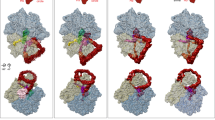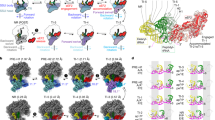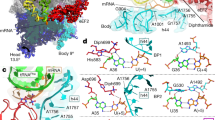Abstract
Accurate translation of genetic information into protein sequence depends on complete messenger RNA molecules. Truncated mRNAs cause synthesis of defective proteins, and arrest ribosomes at the end of their incomplete message. In bacteria, a hybrid RNA molecule that combines the functions of both transfer and messenger RNAs (called tmRNA) rescues stalled ribosomes, and targets aberrant, partially synthesized, proteins for proteolytic degradation1,2. Here we report the 3.2-Å-resolution structure of the tRNA-like domain of tmRNA (tmRNAΔ) in complex with small protein B (SmpB), a protein essential for biological functions of tmRNA. We find that the flexible RNA molecule adopts an open L-shaped conformation and SmpB binds to its elbow region, stabilizing the single-stranded D-loop in an extended conformation. The most striking feature of the structure of tmRNAΔ is a 90° rotation of the TΨC-arm around the helical axis. Owing to this unusual conformation, the SmpB–tmRNAΔ complex positioned into the A-site of the ribosome orients SmpB towards the small ribosomal subunit, and directs tmRNA towards the elongation-factor binding region of the ribosome. On the basis of this structure, we propose a model for the binding of tmRNA on the ribosome.
This is a preview of subscription content, access via your institution
Access options
Subscribe to this journal
Receive 51 print issues and online access
$199.00 per year
only $3.90 per issue
Buy this article
- Purchase on Springer Link
- Instant access to full article PDF
Prices may be subject to local taxes which are calculated during checkout




Similar content being viewed by others
References
Karzai, A. W., Roche, E. D. & Sauer, R. T. The SsrA-SmpB system for protein tagging, directed degradation and ribosome rescue. Nature Struct. Biol. 7, 449–455 (2000)
Keiler, K. C., Waller, P. R. & Sauer, R. T. Role of a peptide tagging system in degradation of proteins synthesized from damaged messenger RNA. Science 271, 990–993 (1996)
Karzai, A. W., Susskind, M. M. & Sauer, R. T. SmpB, a unique RNA-binding protein essential for the peptide-tagging activity of SsrA (tmRNA). EMBO J. 18, 3793–3799 (1999)
Rudinger-Thirion, J., Giege, R. & Felden, B. Aminoacylated tmRNA from Escherichia coli interacts with prokaryotic elongation factor Tu. RNA 5, 989–992 (1999)
Gottesman, S., Roche, E., Zhou, Y. & Sauer, R. T. The ClpXP and ClpAP proteases degrade proteins with carboxy-terminal peptide tails added by the SsrA-tagging system. Genes Dev. 12, 1338–1347 (1998)
Keiler, K. C., Shapiro, L. & Williams, K. P. tmRNAs that encode proteolysis-inducing tags are found in all known bacterial genomes: A two-piece tmRNA functions in Caulobacter. Proc. Natl Acad. Sci. USA 97, 7778–7783 (2000)
Williams, K. P. & Bartel, D. P. Phylogenetic analysis of tmRNA secondary structure. RNA 2, 1306–1310 (1996)
Felden, B. et al. Probing the structure of the Escherichia coli 10Sa RNA (tmRNA). RNA 3, 89–103 (1997)
Someya, T. et al. Solution structure of a tmRNA-binding protein, SmpB, from Thermus thermophilus. FEBS Lett. 535, 94–100 (2003)
Dong, G., Nowakowski, J. & Hoffman, D. W. Structure of small protein B: The protein component of the tmRNA-SmpB system for ribosome rescue. EMBO J. 21, 1845–1854 (2002)
Kim, S. H. Three-dimensional structure of yeast phenylalanine transfer RNA: Folding of the polynucleotide chain. Science 179, 285–288 (1973)
Ushida, C., Himeno, H., Watanabe, T. & Muto, A. tRNA-like structures in 10Sa RNAs of Mycoplasma capricolum and Bacillus subtilis. Nucleic Acids Res. 22, 3392–3396 (1994)
Komine, Y., Kitabatake, M. & Inokuchi, H. 10Sa RNA.is associated with 70S ribosome particles in Escherichia coli. J. Biochem. (Tokyo) 119, 463–467 (1996)
Shi, H. & Moore, P. B. The crystal structure of yeast phenylalanine tRNA at 1.93 Å resolution: A classic structure revisited. RNA 6, 1091–1105 (2000)
Stagg, S. M., Frazer-Abel, A. A., Hagerman, P. J. & Harvey, S. C. Structural studies of the tRNA domain of tmRNA. J. Mol. Biol. 309, 727–735 (2001)
Hanawa-Suetsugu, K., Bordeau, V., Himeno, H., Muto, A. & Felden, B. Importance of the conserved nucleotides around the tRNA-like structure of Escherichia coli transfer-messenger RNA for protein tagging. Nucleic Acids Res. 29, 4663–4673 (2001)
Ibba, M. & Soll, D. Aminoacyl-tRNA synthesis. Annu. Rev. Biochem. 69, 617–650 (2000)
Hou, Y. M. & Schimmel, P. A simple structural feature is a major determinant of the identity of a transfer RNA. Nature 333, 140–145 (1988)
McClain, W. H., Foss, K., Jenkins, R. A. & Schneider, J. Four sites in the acceptor helix and one site in the variable pocket of tRNA(Ala) determine the molecule's acceptor identity. Proc. Natl Acad. Sci. USA 88, 9272–9276 (1991)
Barends, S., Karzai, A. W., Sauer, R. T., Wower, J. & Kraal, B. Simultaneous and functional binding of SmpB and EF-Tu-TP to the alanyl acceptor arm of tmRNA. J. Mol. Biol. 314, 9–21 (2001)
Valle, M. et al. Visualizing tmRNA entry into a stalled ribosome. Science 300, 127–130 (2003)
Price, S. R., Ito, N., Oubridge, C., Avis, J. M. & Nagai, K. Crystallization of RNA-protein complexes. I. Methods for the large-scale preparation of RNA suitable for crystallographic studies. J. Mol. Biol. 249, 398–408 (1995)
Corvaisier, S., Bordeau, V. & Felden, B. Inhibition of transfer messenger RNA aminoacylation and trans-translation by aminoglycoside antibiotics. J. Biol. Chem. 278, 14788–14797 (2003)
Otwinowski, Z. & Minor, W. Processing X-ray diffraction data collected in oscillation mode. Methods Enzymol. 276, 307–326 (1997)
Terwilliger, T. C. Automated structure solution, density modification and model building. Acta Crystallogr. D 58, 1937–1940 (2002)
Brunger, A. T. et al. Crystallography & NMR system: A new software suite for macromolecular structure determination. Acta Crystallogr. D. 54, 905–921 (1998)
Jones, T. A., Zou, J. Y., Cowan, S. W. & Kjeldgaard, M. Improved methods for building protein models in electron density maps and the location of errors in these models. Acta Crystallogr. A 47, 110–119 (1991)
DeLano, W. L. The PyMOL Molecular Graphics System 〈http://www.pymol.org〉 (2002).
Ban, N., Nissen, P., Hansen, J., Moore, P. B. & Steitz, T. A. The complete atomic structure of the large ribosomal subunit at 2.4 Å resolution. Science 289, 905–920 (2000)
Yusupov, M. M. et al. Crystal structure of the ribosome at 5.5 Å resolution. Science 292, 883–896 (2001)
Acknowledgements
We thank C. Schulze-Briese, T. Tomizaki and A. Wagner (SLS, Villigen) D. Sargent, and the team at Swiss Norwegian Beamline (ESRF, Grenoble) for assistance in data collection, V. Ramakrishnan for comments on the manuscript, and D. Goven for help in the footprint assays. P.W.H. is supported by an EMBO fellowship. This work was supported by the Swiss National Science Foundation (SNSF), the NCCR Structural Biology programme of the SNSF, and a Young Investigator grant from the Human Frontier Science Program.
Author information
Authors and Affiliations
Corresponding author
Ethics declarations
Competing interests
The authors declare that they have no competing financial interests.
Supplementary information
41586_2003_BFnature01831_MOESM1_ESM.jpg
Supplementary Figure 1: Chemical and enzymatic footprints of tmRNAΔ as free molecule and in complex with SmpB. (JPG 135 kb)
Rights and permissions
About this article
Cite this article
Gutmann, S., Haebel, P., Metzinger, L. et al. Crystal structure of the transfer-RNA domain of transfer-messenger RNA in complex with SmpB. Nature 424, 699–703 (2003). https://doi.org/10.1038/nature01831
Received:
Accepted:
Issue Date:
DOI: https://doi.org/10.1038/nature01831
This article is cited by
-
De novo computational RNA modeling into cryo-EM maps of large ribonucleoprotein complexes
Nature Methods (2018)
-
MultiSETTER: web server for multiple RNA structure comparison
BMC Bioinformatics (2015)
-
Mechanisms of ribosome rescue in bacteria
Nature Reviews Microbiology (2015)
-
The complex of tmRNA–SmpB and EF-G on translocating ribosomes
Nature (2012)
-
tmRNA–SmpB: a journey to the centre of the bacterial ribosome
The EMBO Journal (2010)
Comments
By submitting a comment you agree to abide by our Terms and Community Guidelines. If you find something abusive or that does not comply with our terms or guidelines please flag it as inappropriate.



